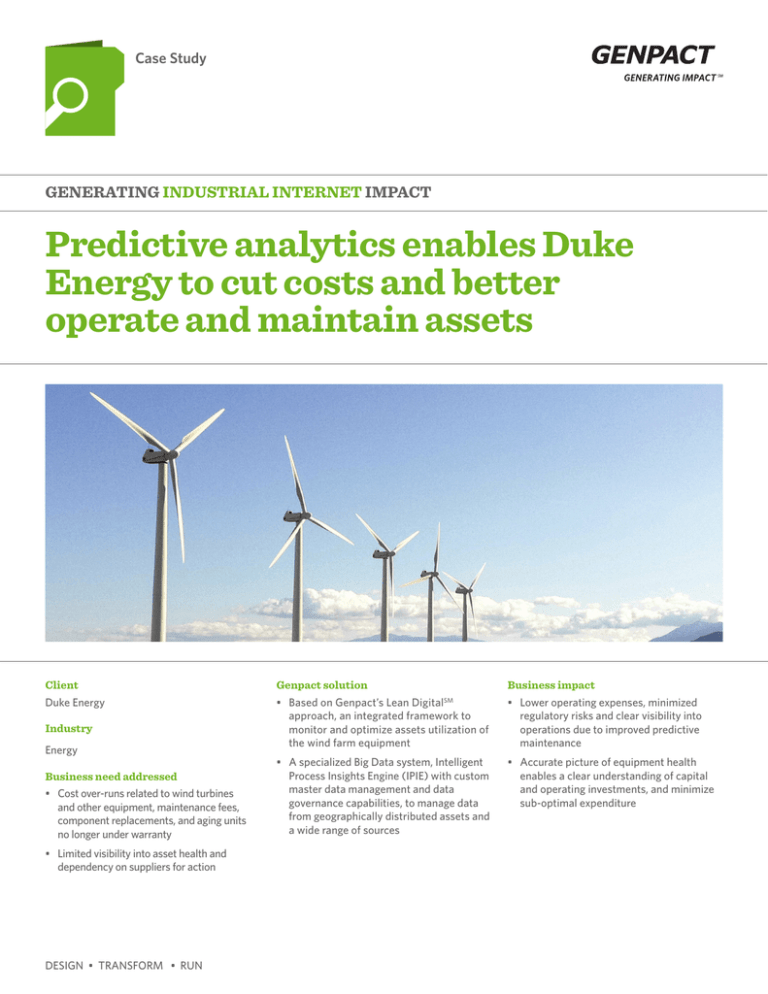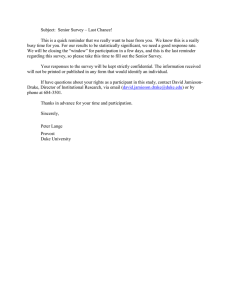
Case Study
GENERATING Industrial INTERNET IMPACT
Predictive analytics enables Duke
Energy to cut costs and better
operate and maintain assets
Client
Genpact solution
Business impact
Duke Energy
• Based on Genpact’s Lean DigitalSM
approach, an integrated framework to
monitor and optimize assets utilization of
the wind farm equipment
• Lower operating expenses, minimized
regulatory risks and clear visibility into
operations due to improved predictive
maintenance
• A specialized Big Data system, Intelligent
Process Insights Engine (IPIE) with custom
master data management and data
governance capabilities, to manage data
from geographically distributed assets and
a wide range of sources
• Accurate picture of equipment health
enables a clear understanding of capital
and operating investments, and minimize
sub-optimal expenditure
Industry
Energy
Business need addressed
• Cost over-runs related to wind turbines
and other equipment, maintenance fees,
component replacements, and aging units
no longer under warranty
• Limited visibility into asset health and
dependency on suppliers for action
DESIGN • TRANSFORM • RUN
Duke Energy, the largest electric power holding company in the United
States, struggled with cost levels and predictability, as well as control and
optimization of assets. The company used a practical Lean DigitalSM approach
to reimagine its maintenance and repair processes, implementing a Datato-Insight-to-Action analytics process that transformed operations and
successfully addressed business challenges.
Business challenge
Genpact solution
Duke Energy is the largest electric power holding
company in the United States, supplying and
delivering energy to approximately 7.3 million
US customers, and its subsidiary, Duke Energy
Renewables, is a leader in developing innovative wind
and solar energy solutions. To maintain its strong
position in the market, Duke Energy Renewables
developed a three-pronged strategy: improve
customer service, establish long-term purchase
agreements with those customers in support of a
more predictable revenue model, and maximize
utilization of expensive investments—more than $3
billion, since 2007—in wind and solar power projects.
Duke Energy realized that standalone advanced
technology and analytics initiatives could quickly
sap management’s energy and bandwidth without
a clear line of sight on
promised outcomes.
A specialized
A Lean DigitalSM
Big Data system,
approach — combining
digital technologies,
the Intelligent
and Lean principles —
Process Insights
proved instrumental in
Engine (IPIE), was
helping the company
applied to manage
achieve a new level of
data derived from
excellence. First, Duke
geographically
Energy identified its
key business outcomes,
distributed assets.
and then determined
how to source and
transform relevant data from appropriate sources
and supporting processes. Next, it used analytics
to make critical information visible to all relevant
stakeholders — from field to management — to
enhance the quality of decision-making and
prioritize interventions at scale. Focused use of
digital technology complemented legacy technology
and helped reimagine processes to make the
interventions practical and generate impact faster.
Seven original equipment manufacturers (OEM),
each having their own custom monitoring software
systems supply the vast rows of turbines that turn
wind into energy for Duke Energy. The volume of
data produced by the OEMs’ systems was growing
exponentially, and they were struggling to derive
insights from it. The OEMs’ cost projections
were often inconsistent with the actual data.
Maintenance fees, component replacement,
and aging units no longer under warranty were
degrading the operation’s financial performance.
Duke Energy needed a new framework to optimize
their industrial assets utilization in order to better
monitor the operational and financial health of the
powerful equipment so vital to its wind farms.
Duke Energy started with an inventory of the
company’s data-capture and data-cleanup
procedures to establish a context for the data
already available. Rather than consider each
OEM – and the information it contributed —
discretely, Duke Energy decided on a more holistic
approach, taking the entire operation into account.
Specifically, they introduced a system for evaluating
each wind farm as a whole, rather than assessing
every turbine in a piecemeal manner.
A specialized Big Data system, the Intelligent
Process Insights Engine (IPIE), was applied
to manage data derived from geographically
distributed assets.
The platform’s robust master data management
and data governance helped analysts look beyond
information maintenance toward using it for
predictive analytics as an enhanced decisionmaking tool. To minimize equipment failures
and limit maintenance costs, the utility provider
designed a consolidated approach that integrated
data from a wide range of sources beyond the
OEMs, including meteorologists and technicians
in the field.
Importantly, and in departure from many typical
analytics exercises, advanced organizational
2 Run Data-to-Insight
•Specialized big data system:
Intelligent Process Insight
Engine (IPIE) process data
from multiple systems and
integrated new sources like
meteorological and field
technician data
Business impact
Duke Energy is now more predictive about the
condition of its equipment. The technicians and
site managers responsible for operations are
now equipped with proactive suggestions on
repairs and scheduling preventive maintenance.
Additionally, Duke Energy is able to share
actionable insights across functions, embedding
PR
O
SIB VID
ILI E
TY
R ESS
EE
ST IVEN
CT
FE
EF
Gather
feedback
VI
Analyze
EXECUTE
ACTIONS
Implement
4 Continuous learning
•Data mining and simulation
to enable optimized
maintenance planning at a
farm level
•Proactive identification and
prevention of causes of
downtime
Improve execution
practices
Correct
strategy and
targets
Consolidate,
report
•Reliability analytics – by
turbine and component
•Performance analytics
structures such as an analytics Center of
Excellence (CoE) helped embed and sustain
the improvement.
The platform’s
Continuous tuning
robust master
and improvements
were guided by the
data management
institutionalization of
and data
the learning gleaned
governance
from outcomes of prior
helped analysts
iterations. The result: a
design of operations that look beyond
information
makes them “intelligent”
(see Figure 1) – able to
maintenance
sense, act appropriately,
and learn from their actions.
Figure 1
•Accurate projections for
operating cost, and related
charges (depreciation,
insurance)
Measure
1
Operate
3
•Improved scheduling of
preemptive maintenance
based on accurate failure/
remaining useful life
prediction
•Identify target outcome: revenue,
margins
•Identify metrics: power demand
fulfillment, asset downtime,
capacity factor, availability,
operating costs (including
maintenance, repair and servicing)
them further into the fabric of the enterprise.
Predictive maintenance has reduced operating
expenses, lowered the regulatory risk, and
provided the CEO with a clear picture of the
company’s available power inventory. Duke
Energy’s engineers are providing more precise
information on asset wear to OEMs, who in turn
use the information to develop new manufacturing
methods. The technology teams can now gauge
equipment wear more precisely and evaluate
new methods of manufacturability and design
of components going forward. For the CFO, an
accurate picture of equipment health enables a
clear understanding of how to manage equipment
depreciation in terms of capital and operating
investments – and ultimately, the bottom line.
This holistic approach raises the prospect that
it can beat the performance it achieved with its
initial investment.
Company leaders say they intend to further
industrialize their processes – and they find
themselves on what they describe as an
“institutional learning curve.” In the process,
according to Duke Energy executives, the company
has reassessed its core competencies and
reimagined its entire enterprise, creating in the
process a foundation for future innovation.
About Genpact
Genpact (NYSE: G) stands for “generating business impact.” We architect the Lean DigitalSM enterprise through a unique approach based
on our patented Smart Enterprise Processes (SEPSM) framework that reimagines our clients’ middle and back offices to generate growth, cost
efficiency, and business agility. Our hundreds of long-term clients include more than one-fourth of the Fortune Global 500. We have grown
to over 70,000 people in 25 countries, with key management and a corporate office in New York City. We believe we are able to generate
impact quickly and power Intelligent OperationsSM for our clients because of our business domain expertise and experience running complex
operations, driving our unbiased focus on what works and making technology-enabled transformation sustainable. Behind our passion for
technology, process, and operational excellence is the heritage of a former General Electric division that has served GE businesses since 1998.
For additional information, contact, industrial.manufacturing@genpact.com and visit www.genpact.com/home/industries/industrialmanufacturing
Follow Genpact on Twitter, Facebook, LinkedIn, and YouTube.
© 2015 Copyright Genpact. All Rights Reserved.





